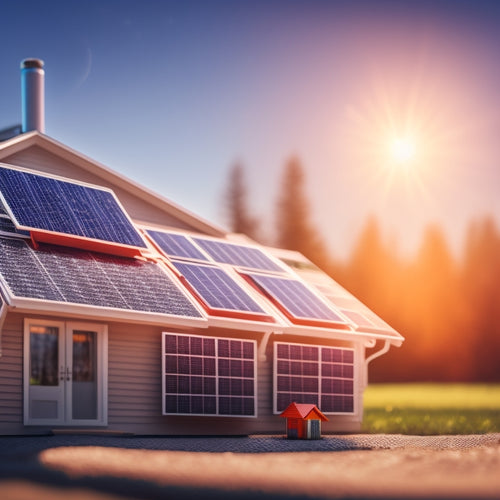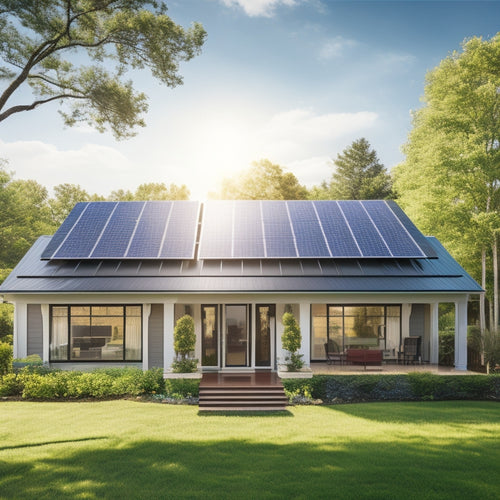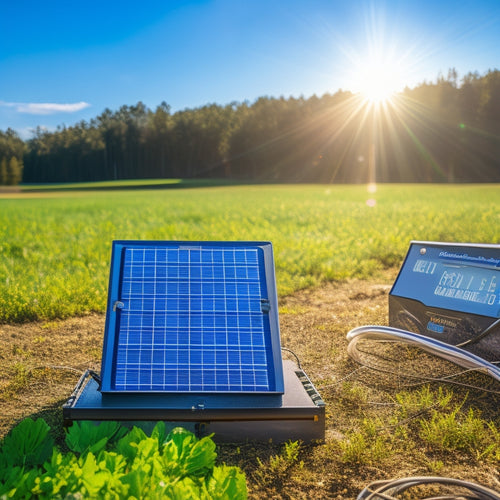
Solar Panel Storage
Share
You're considering solar panel storage to maximize your energy harvesting potential, and rightly so, as it's a vital step in optimizing your energy output and reducing your reliance on the grid. Proper solar panel angling, regular cleaning, and efficient energy management guarantee you get the most out of your system. A high-quality solar battery, like lithium-ion, stores excess energy for later use, providing grid independence and cost savings. To determine the right storage capacity, calculate your daily energy use and peak power needs. Understanding these factors will help you make informed decisions about your solar panel storage system - and there's more to investigate regarding technology and selection.
The Essentials
- Maximizing energy harvesting potential through proper solar panel angling, cleaning, and maintenance is crucial for optimal energy output.
- Energy storage capacity is critical for solar panel system performance, and higher capacity allows for more excess energy storage.
- Solar batteries store excess energy for nighttime or cloudy day use, providing grid independence and cost savings with efficient energy management.
- Deep cycle battery selection depends on factors like depth of discharge, total watt-hours capacity, and round-trip efficiency to minimize energy loss.
- Accurate calculation of daily energy use and peak power needs is essential for sizing a solar panel storage system to meet energy demands.
Maximize Energy Harvesting Potential
You'll want to optimize your solar panel's energy output by ensuring it's properly angled, cleaned, and maintained to maximize its energy harvesting potential.
To achieve this, you'll need to take into account factors like shading, temperature, and panel efficiency. By doing so, you can then pair your optimized energy output with an efficient Renewable Energy system, such as a high-quality house solar battery, to maximize your overall energy independence.
This will allow you to store excess energy generated by your solar panels and use it during off-peak hours or emergencies.
Optimizing Energy Output
To maximize energy harvesting potential, it's essential to optimize the energy output of your solar panel system. You can achieve this by focusing on solar efficiency, which is vital to generating the most energy possible from your solar panels.
Effective energy management is also key, as it enables you to monitor and control your energy consumption in real-time. Grid integration is another important aspect, as it allows you to feed excess energy back into the grid and receive renewable incentives.
A well-designed Solar Array addresses these common problems by not only reducing the financial burden through affordable and cost-effective solutions, but also maximizing energy conversion rates through cutting-edge technology, and simplifying the installation process with user-friendly configurations.
Proper installation techniques and maintenance practices are essential to guarantee your system operates at peak performance. Smart technology, such as performance monitoring systems, can help identify areas for improvement and optimize energy output.
Additionally, confirming system compatibility and conducting a thorough cost analysis can help you make informed decisions about your solar panel system. By optimizing your energy output, you can increase your energy independence and reduce your reliance on the grid.
With the right approach, you can access the full potential of your solar panel system and enjoy the freedom that comes with generating your own clean energy.
Energy Storage Systems
How do you guarantee that the energy generated by your solar panel system is available when you need it most? The answer lies in energy storage systems, an essential component of maximizing energy harvesting potential.
By integrating a solar battery into your system, you can store excess energy generated during the day for use during the night or on cloudy days. This not only guarantees a steady supply of renewable energy but also provides grid independence, reducing your reliance on the grid and resulting in cost savings.
With the advancement of Lithium-Ion Batteries, homeowners can now enjoy more efficient and reliable energy storage solutions. Additionally, smart energy management features enable homeowners to monitor performance and optimize energy storage.
This will allow you to monitor performance, optimize energy storage, and make energy efficiency upgrades as needed. By leveraging energy storage benefits, you can take control of your home energy solutions and enjoy the freedom that comes with it.
Reduced Carbon Footprint Guarantee
You'll greatly reduce your carbon footprint by opting for eco-friendly energy solutions that maximize green energy potential.
By utilizing renewable energy from solar panels, you'll minimize your reliance on fossil fuels and lower greenhouse gas emissions.
With efficient and durable house solar panels, you can generate renewable energy and save on electricity bills.
As a result, you'll contribute less to climate change and create a more sustainable future.
Eco-Friendly Energy Solutions
Over 90% of the world's energy is generated from fossil fuels, resulting in a notable carbon footprint that contributes to climate change.
As you shift to solar panel storage, you're likely looking for eco-friendly energy solutions that align with your values. You're not alone - many individuals and organizations are seeking sustainable practices to reduce their environmental impact.
Renewable innovations have made considerable progress in recent years, offering viable alternatives to fossil fuels.
Maximize Green Energy Potential
With solar panel storage, your ability to maximize green energy potential becomes a tangible reality, translating to a significant reduction in your carbon footprint. You'll be utilizing the full power of the sun, reducing your reliance on non-renewable energy sources and contributing to a cleaner environment.
By storing excess energy generated during the day for use at night or during periods of low sunlight, you'll achieve energy independence and minimize your impact on the planet. Additionally, you'll benefit from solar incentives, such as tax credits and rebates, which can help offset the initial investment in your solar panel system.
Here's a breakdown of the benefits you can expect from maximizing your green energy potential:
| Category | Benefits | Results |
|---|---|---|
| Environmental | Reduced carbon footprint | Cleaner air and water |
| Financial | Solar incentives and rebates | Lower energy bills |
| Energy | Energy independence | Unreliance on grid power |
| Social | Contribution to a sustainable future | Enhanced community reputation |
| Personal | Freedom from energy uncertainty | Peace of mind |
Deep Cycle Battery Technology
You're likely familiar with the significance of battery life cycles in deep cycle battery technology, as it directly impacts the overall performance of your solar panel storage system.
When it comes to achieving home energy independence, a reliable residential solar batteries solution is essential. The number of charge/discharge cycles a battery can handle determines its lifespan, making it a vital factor to take into account.
When evaluating energy storage capacity, you'll want to assess the battery's ability to store and release energy efficiently, ensuring a reliable and consistent power supply.
Battery Life Cycles
A typical deep cycle battery undergoes around 300 to 500 charge/discharge cycles before its capacity degrades to 80% of the original rating. This lifespan depends on various factors, including your battery maintenance habits.
You'll want to guarantee proper charge management to extend the battery's life. This means avoiding deep discharging, as it can reduce the battery's overall lifespan.
You should also monitor the battery's state of charge, as overcharging can lead to degradation. Regularly checking the battery's voltage and specific gravity will help you detect any issues early on.
Additionally, keeping the battery in a cool, dry environment will also contribute to its longevity. It's crucial to follow the manufacturer's guidelines for maintenance and charging to get the most out of your deep cycle battery.
Energy Storage Capacity
Your deep cycle battery's energy storage capacity is a critical factor in determining the overall performance of your solar panel storage system. It directly affects how efficiently your solar panels generate power and how well your storage solutions meet your energy needs. A higher energy storage capacity means you can store more excess energy generated by your solar panels during the day for use during the night or on cloudy days.
When selecting a deep cycle battery, consider the depth of discharge (DOD) and the total watt-hours (Wh) capacity. A higher DOD rating means you can drain the battery further without damaging it, while a higher Wh capacity means you can store more energy. Look for batteries with a high DOD rating (around 80%) and a Wh capacity that matches your energy needs.
To maximize solar efficiency, choose a battery with a high round-trip efficiency (RTE) rating. This measures how efficiently the battery stores and releases energy. A higher RTE rating means less energy is wasted as heat, ensuring you get the most out of your solar panel storage system.
Check Your Wattage Needs
You need to calculate your daily energy use to determine the required storage capacity of your solar panel system. This involves identifying the total wattage of your appliances and devices, as well as their individual usage patterns.
For a smooth shift to renewable energy solutions, consider integrating home energy storage systems that can power your home during outages.
Calculate Daily Energy Use
To accurately size a solar panel storage system, it's essential to determine how much energy your appliances and devices consume daily. This involves calculating your total daily energy use, which is typically measured in watt-hours (Wh).
You'll need to identify the devices you want to power with your solar panel storage system and their respective energy consumption rates. Start by making a list of all the devices you want to power, including lights, laptops, refrigerators, and other appliances.
Note the wattage of each device, usually found on the manufacturer's label or in the user manual. Then, estimate how many hours you'll use each device daily. Multiply the wattage by the usage hours to get the daily energy consumption in Wh.
Add up the energy consumption of all devices to get your total daily energy use. Understanding your usage patterns is key to accurately sizing your solar panel storage system.
Identify Peak Power Needs
Calculating daily energy use provides a solid foundation for sizing a solar panel storage system, but it's equally important to identify peak power needs to guarantee the system can handle sudden surges in demand.
When you're sizing your system, you need to evaluate the times when your energy demand is highest, such as when you're using multiple appliances simultaneously.
To determine your peak consumption, you'll need to calculate the maximum power required by your appliances when they're operating at the same time. This can be done by adding up the wattage of each device, considering their individual power ratings and usage patterns.
For example, if you have a refrigerator, air conditioner, and lights running simultaneously, you'll need to calculate the total wattage required to power these appliances.
Lithium-Ion Beats Lead Acid
When it comes to choosing a battery for your solar panel storage system, you'll likely be deciding between lithium-ion and lead acid options.
Lithium-ion batteries have a significant advantage when it comes to cycle life, with some models lasting up to 5,000 cycles or more.
In contrast, lead acid batteries typically top out at around 1,000 to 2,000 cycles, making lithium-ion a clear winner in this regard.
Longer Cycle Life
Your solar panel storage system's lifespan heavily relies on the cycle life of its batteries.
Lithium-ion batteries outperform lead-acid batteries in this regard, boasting a markedly longer cycle life. This means you can expect lithium-ion batteries to last for thousands of charge/discharge cycles, whereas lead-acid batteries typically max out at around 500 cycles.
This increased cycle life translates to a longer overall lifespan for your solar panel storage system, reducing the need for frequent replacements and minimizing waste.
The superior cycle efficiency of lithium-ion batteries is due to their ability to handle deeper discharge cycles without suffering from capacity loss.
This, combined with their lower self-discharge rate, results in a longer lifespan and reduced maintenance needs.
Longevity factors, such as the battery's ability to withstand extreme temperatures and resist degradation, also contribute to the extended cycle life of lithium-ion batteries.
Frequently Asked Questions
Can I Use Solar Panel Storage for My RV or Boat?
When you're on the move, you can utilize the sun's power for your RV or boat, but you'll need to take into account solar efficiency and battery capacity to guarantee you're generating enough juice to keep your escapades running smoothly.
How Long Does It Take to Charge a Solar Panel Storage System?
When you're on a roll, you want to know how long it takes to refuel. Charging time depends on your system's charging efficiency and battery capacity; for example, a 400Ah battery with 90% efficiency might take around 5-6 hours to fully charge.
Are Solar Panel Storage Systems Weather-Resistant and Durable?
When investing in a system, you'll want to verify it withstands the elements; look for weather resilience and durability features like waterproofing, rust-resistant materials, and sturdy construction to guarantee your energy independence isn't compromised.
Can I Install Solar Panel Storage Myself or Do I Need a Pro?
When tackling a DIY installation, you'll need to weigh the risks: ensuring safety considerations like electrical connections and structural integrity are met, or hiring a pro to guarantee a secure, efficient setup.
Are There Any Government Incentives for Solar Panel Storage Systems?
As you initiate a voyage to utilize the sun's golden rays, you'll be thrilled to uncover that Uncle Sam offers a helping hand; you can tap into tax credits, reaping energy savings and watching your wallet smile, all while embracing a cleaner, greener tomorrow.
Final Thoughts
With solar panel storage, you've revealed the secret to utilizing the sun's limitless energy. By maximizing your energy harvesting potential, you've reduced your carbon footprint to near zero. Armed with deep cycle battery technology and a clear understanding of your wattage needs, you've made the smart switch to lithium-ion batteries, leaving outdated lead acid batteries in the dust. Now, you're generating enough power to light up a small town - or at least, your entire home, with ease and efficiency.
Related Posts
-

A Beginner's Guide to Navigating the Solar Investment Tax Credit
You're eligible to claim a significant Solar Investment Tax Credit (ITC) of 30% of total installation costs, but mane...
-

Home Solar Installation Cost
You're considering installing solar panels on your home, and the upfront cost is likely the biggest hurdle standing i...
-

Choosing the Right Solar Power Charge Controller
Choosing the right solar power charge controller is crucial for maximizing energy efficiency and extending battery li...


